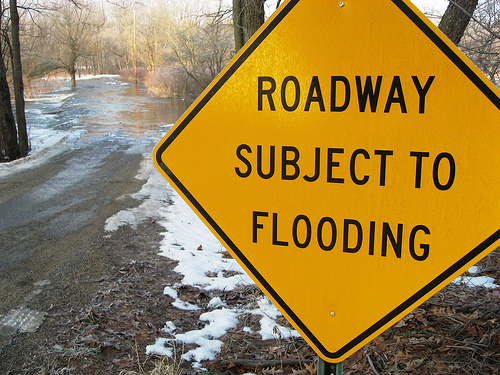 Pay attention to the signs.Photo: WCN 24/7True or false: Risks of a climate catastrophe can be ignored, even as temperatures rise? The economic impact of climate change is no greater than the increased cost of air conditioning in a warmer future? The ideal temperature for agriculture could be 17 degrees C (30 degrees F) above historical levels?
Pay attention to the signs.Photo: WCN 24/7True or false: Risks of a climate catastrophe can be ignored, even as temperatures rise? The economic impact of climate change is no greater than the increased cost of air conditioning in a warmer future? The ideal temperature for agriculture could be 17 degrees C (30 degrees F) above historical levels?
All true, according to the increasingly popular Climate Framework for Uncertainty, Negotiation, and Distribution (FUND) model of climate economics. It is one of three models used by the federal government’s Interagency Working Group to estimate the “social cost of carbon” — that is, the monetary value of the long-term damages done by greenhouse gas emissions. According to FUND, as used by the Working Group, the social cost of carbon is a mere $6 per ton of CO2. That translates into $0.06 per gallon of gasoline. Do you believe that a tax of $0.06 per gallon at the gas pump (and equivalent taxes on other fossil fuels) would solve the climate problem and pay for all future climate damages?
I didn’t believe it, either. But the FUND model is growing in acceptance as a standard for evaluation of climate economics. To explain the model’s apparent dismissal of potential harm, I undertook a study of the inner workings of FUND [PDF] (with the help of an expert in the relevant software language) for E3 Network. Having looked under the hood, I’d say the model needs to be towed back to the shop for a major overhaul.
FUND includes estimates of 15 categories of climate impacts, each calculated separately for 16 regions of the world. Yet most of the climate impacts, as seen by FUND, are too small to matter. Under the U.S. government assumptions (including a 3 percent discount rate), what goes into FUND’s total climate damage estimate of $6 per ton of CO2? It consists of $8 for net increases in cooling and heating costs — those pesky air conditioning bills — minus $6 of net benefits in agriculture, plus $4 in damage costs for everything else.
It’s a little hard to fathom how “everything else” ends up so small. Sea-level rise, storm damages, droughts and floods, human deaths and diseases, extinction of species, forced migration of huge numbers of climate refugees: All that and more is valued at $4 per ton. Just two of those categories, water supply problems and extinction of species, account for $2, with a mere $2 remaining for everything else. Catastrophes — collapse of major ice sheets, accelerated methane releases from tundra or clathrates, collapse of rainforests, drastic changes in ocean currents — are excluded in FUND by definition.
We took a closer look at FUND’s net benefit of climate change in agriculture, and found three major problems. First, there’s a flat-out algebra mistake: FUND comes dangerously close to dividing by zero, which can lead to meaninglessly large calculations (this is scheduled to be fixed in the next version of the FUND software, but it affects the current U.S. government version and all FUND calculations to date).
Second, FUND explores an implausibly wide range of supposedly beneficial temperatures. In the case of South America, FUND’s 95 percent confidence interval on the ideal temperature for agriculture extends to 17 degrees C above and below historical levels.
Third, FUND’s treatment of agriculture is based on very old research, all from 1996 or earlier. Back in those days, estimates of near-term agricultural benefits from warming were common; since then, newer research has steadily reduced those benefit estimates and introduced new ways of approaching the problem. As it turns out, the rise in average temperatures is not as important as the number of days above a temperature threshold, 32 degrees C (90 degrees F) or less for some major crops — and climate change means that those damaging temperature extremes will occur much more often.
Quick fixes for some of the problems in FUND’s agriculture calculations would imply increases in the social cost of carbon of $10 to $16. These ad hoc fixes to the model, however, are no substitute for a thorough overhaul of its damage estimates. Until that overhaul occurs, FUND should be treated as a work in progress, not a definitive evaluation of the economics of climate change. It’s not ready for use in U.S. government estimates of the social cost of carbon, or for other policy-making purposes.



